1884 - Atchison Topeka & Santa Fe
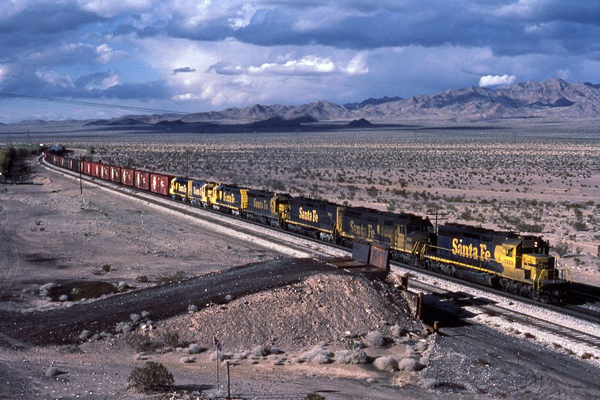
Lance Buckhammer photo - I-40 overpass, Barstow, 1985
Atchison, Topeka and Santa Fe Railway Company, byname Santa Fe Railway, former railway that was one of the largest in the United States. Chartered in Kansas as the Atchison and Topeka Railroad Company in 1859, it later exercised great influence on the settlement of the southwestern United States. It was renamed the Atchison, Topeka and Santa Fe Railroad in 1863 and acquired its modern name in 1895. Its founder was Cyrus K. Holliday, a Topeka lawyer and business promoter, who sought to build a railroad along the Santa Fe Trail, a 19th-century trading route that ran from Independence, Mo., to Santa Fe, N.M. The railroad’s main line to the Colorado state line was completed in 1872.
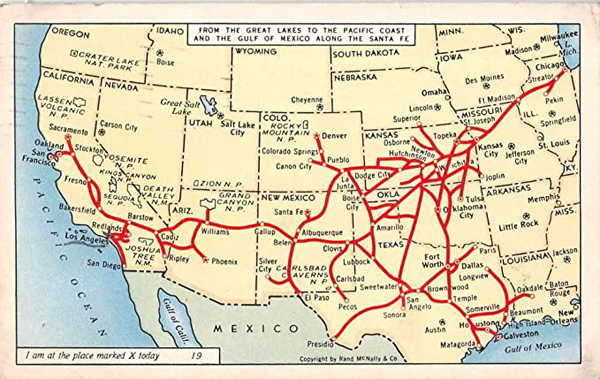
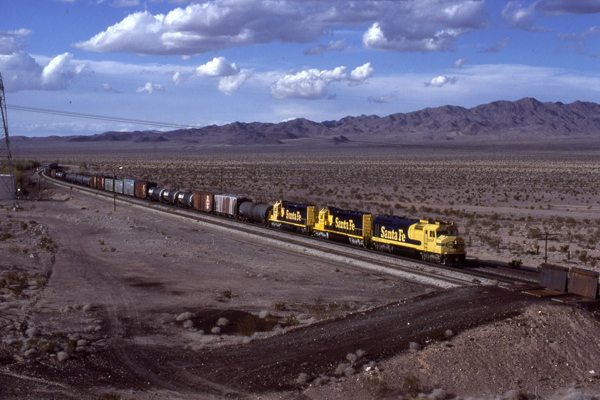
Lance Buckhammer photo - I-40 overpass, Barstow, 1985
The railroad was further expanded in the 1880s and early 1890s to reach about 9,000 miles (14,480 km), but it lost some of this mileage in a reorganization brought on by the financial crisis of 1893. Under Edward Payson Ripley, its president from 1895 until 1920, the Santa Fe flourished and grew to more than 11,000 miles (17,700 km) of track. By 1941 it had more than 13,000 miles (21,000 km) of track, but it shrank gradually thereafter. In 1968 the company became a subsidiary of Santa Fe Industries, Inc., a holding company. In 1983 this company and the Southern Pacific Transportation Company agreed to merge into the Santa Fe Southern Pacific Corporation, but the merger was rejected by the ICC in 1987. The Southern Pacific rail system was sold off in 1988, and in 1989 the Santa Fe parent company became known simply as the Santa Fe Pacific Corporation. Burlington Northern, Inc., purchased the Santa Fe Pacific Corporation in 1995, and the resulting company took the name Burlington Northern Santa Fe Corporation.
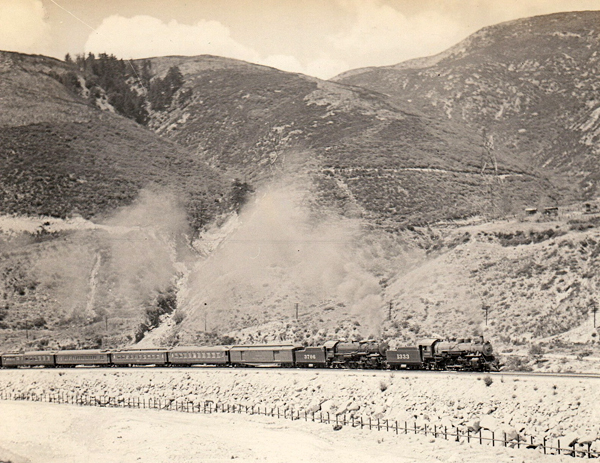
Cajon Pass, June 1941
Before it was acquired by the Burlington Northern railroad, the Santa Fe Railway covered 12 states, with most of its trackage in the midwestern and southwestern portions of the United States. Its freight revenues came principally from intermodal traffic, farm and food products, chemicals, motor vehicles and parts, and industrial raw materials. The days of its famed passenger trains such as the Super Chief were largely over by 1970, and it sold its passenger service to the National Railway Passenger Corporation (Amtrak) in 1971.
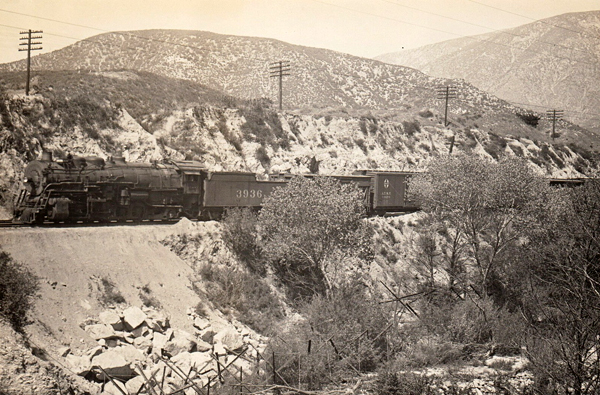
Cajon Pass, June 1941
Atchison, Topeka and Santa Fe Railway Company American railway
Written By: The Editors of Encyclopaedia Britannica
britannica.com/topic/Atchison-Topeka-and-Santa-Fe-Railway-Company
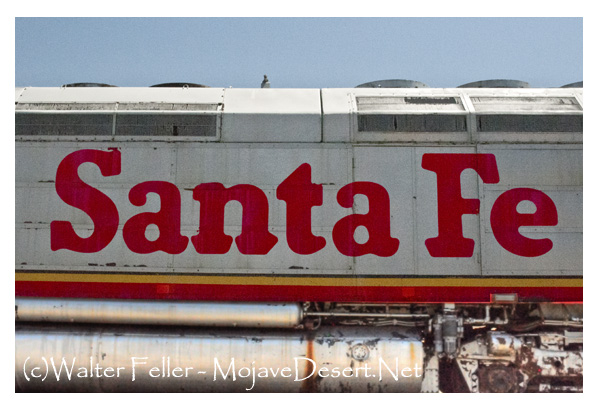
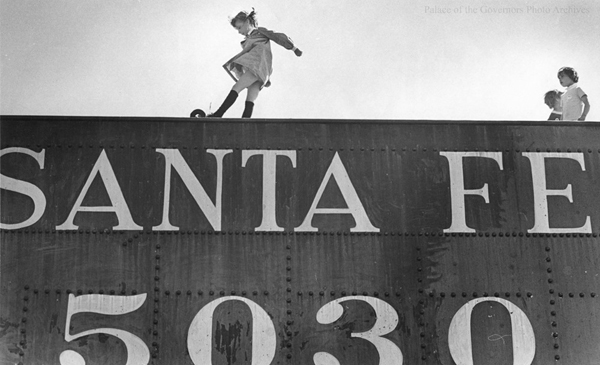
Feature Articles and Related Pages
Railroad History in the Mojave Preserve
In addition to the trans-desert route of the Santa Fe, ... The railroad, though not as busy as the Burlington Northern Santa Fe route to the south, ...
Kelso Depot
Stiff competition with the Santa Fe Railroad was of prime concern in this region ... The comparison of our facilities with those of the Santa Fe at Barstow, ...
Kelso Depot
Inter-railroad competition was lively, and UP was determined to put up buildings that would rival the Harvey Houses of the Santa Fe lines. ...
Ludlow, CA
About 1898 John Suter, a roadmaster for the Santa Fe, headed into the hills south of Ludlow looking for water. Instead of water, he discovered gold, . ...
Helendale, CA
The Santa Fe Railroad arrived in the 1880s and built a Point of Rocks station, which provided a watering stop for the steam engine locomotives then moving ...
History of Homesteading in the Mojave Preserve
Future residents would rent a boxcar from the Santa Fe Railway, ... When the Santa Fe abandoned its railroad line through the area in 1923, many left, ...
Stedman Ghost Town
About 1898 John Suter, a roadmaster for the Santa Fe, headed into the hills south of Ludlow ... Ecology. Mojave Valley - Granite Mountains ...
History of Victorville
It was named after Jacob Nash Victor, a construction superintendent for the California Southern Railroad (Santa Fe Railroad). The town was established as a ...
Route 66, Goffs
Goffs was a rail junction from 1893 to 1923 serving both a desert shortline and the Santa Fe mainline. In 1902 Santa Fe developed facilities and a depot was ...
Cadiz, California
Salt ...It was previously the Atchison, Topeka and Santa Fe Railway line. Also at Cadiz, the Arizona & California Railroad runs over a former ATSF line to Phoenix ...
The Southern Pacific and later Santa Fe transcontinental route
However, the Santa Fe crowd was not without its own leverage, and threatening to parallel the Southern Pacific all the way to San Francisco and by other ...
The Smallest Railways
What began as one morphed into three railways north from Goffs which all became wholly-owned subsidiaries of the Santa Fe System. The first of these was the ...
Railroads of the Mojave Desert
Stiff competition with the Santa Fe Railroad was of prime concern in this . .... With the coming of the Santa Fe Railroad, water and other supplies were ...
The Salt Lake Route
The Atchison, Topeka & Santa Fe System had worked out with an entrepreneur named Fred ... After the Santa Fe bankruptcy in the 1890s and its reorganization, ...
The Tonopah & Tidewater Railroad
... eleven miles north of Daggett on the Atchison, Topeka & Santa Fe, to which they had built a narrow gauge ore railroad known as the Borate & Daggett. ...
Copper Basin
One stimulus for mining in Copper Basin was the anticipated arrival of the Santa Fe Railroad, then working its way across Arizona. But the Santa Fe did not ...
BAGDAD AREA
The Bagdad area lies in the heart of San Bernardino County, roughly bordered on the north by Interstate 40, the east by the Parker Branch of the Santa Fe ...
History of the Eastern Mojave
A more serious blow came in 1883 when another trans-continental railroad, todays Burlington Northern/Santa Fe, was completed just south of the Mojave Road. ...
The Mojave Desert - People in the Mojave
With the coming of the Santa Fe Railroad, water and other supplies were made available to companies intent on capitalizing on the Mojave's resources. ...
Baghdad-Chase Gold Mine
About 1898 John Suter, a roadmaster for the Santa Fe, headed into the hills south of Ludlow looking for water. Instead of water, he discovered gold, ...
Rosalie - Clark Mountain - Mojave Desert Minig History
The ore was hauled by teams to Ivanpah, and shipped via the California Eastern and Santa Fe Railroads to the Needles smelter, run by Godshall. 146 ...
Mining Operations in the Whipple Mountains
They intended to walk along the Santa Fe and stop at the principal points, advertising the new gold camp by panning the ore. After arriving in Los Angeles ...
Mining in the Old Woman Mountains
After the Parker branch of the Santa Fe was built, Price, in partnership with Bert Day, began working the mine. In March, 1911, the shaft was down to 60 ...
Railroads in the Mojave
The coming of the Santa Fe Railroad changed everything. They could haul in food and haul out ore faster and cheaper than the large wagons designed ...
Ft. Mojave Indian Tribe - Mojave Desert
Many turned to the Atlantic and Pacific Railroad (later the Santa Fe), which came to Needles in 1883. Others worked on river boats, in the mines, ...
Kramer
In July 1884, the Kramer Siding on the Santa Fe Railroad had but one inhabitant, the depot agent. However, with the discovery of copper 3 miles to the south ...
Orange Blossom Mine
John Denair, division superintendent for the Santa Fe and a resident of Needles, was president of this concern and Judge L. V. Root was secretary. ...
Borax at Death Valley
The nearby town of Newberry Springs was first choice for Santa Fe Railroad, when deciding to establish a major crossroads that would bring people and ...
MINING IN NORTHWEST SAN BERNARDINO COUNTY
In July 1884, the Kramer Siding on the Santa Fe Railroad had but one inhabitant, the depot agent. However ... Coolgardie. About May, 1900, placer gold was ...
Founding and Early Years
1859:
The AT&SF was chartered by the Kansas Territorial Legislature to serve a route from Atchison, Kansas, to Santa Fe, New Mexico. Initially, it was intended to serve as a trade link following the famous Santa Fe Trail.1863:
Construction began, and by the late 1860s, the railroad reached Topeka, initiating a period of rapid expansion.Expansion Period
1870s-1880s:
Under the leadership of President Thomas Nickerson, the Santa Fe extended its reach into Colorado, and later into Texas. The railway continued its expansion toward the west coast.1880:
The railroad achieved a major goal by reaching Albuquerque, New Mexico.1881:
Santa Fe connected to the Pacific Ocean for the first time via a link with the Southern Pacific at Deming, New Mexico.1887:
The railroad's tracks reached Los Angeles, California, enhancing its growth potential by connecting to the Pacific and opening up new markets.Innovations and Developments
1895:
Santa Fe introduced the famous "Harvey Houses" — a series of hotels and restaurants along the route that provided quality accommodations and meals to travelers, significantly improving the travel experience.Early 1900s:
The railroad introduced the famous "Santa Fe de Luxe" and later the "Chief" luxury passenger trains, which became symbols of high-quality rail travel.Mid-20th Century Changes
1951:
The Santa Fe merged with the St. Louis-San Francisco Railway, enhancing its network.1971:
The passenger services of Santa Fe were taken over by the newly formed Amtrak, as was the case with most American railroads, leading Santa Fe to focus on freight transportation.Later Years and Merger
1990s:
In a significant move, the Santa Fe merged with the Burlington Northern Railroad in 1995 to form the Burlington Northern and Santa Fe Railway (BNSF), which continues to be a major freight railroad in the United States.The Santa Fe Railroad was known for its picturesque routes, innovative services, and a strong connection to the cultural and economic development of the regions it served. Its legacy continues through BNSF and through the iconic imagery and cultural references it inspired, like the famous song "On the Atchison, Topeka and the Santa Fe."